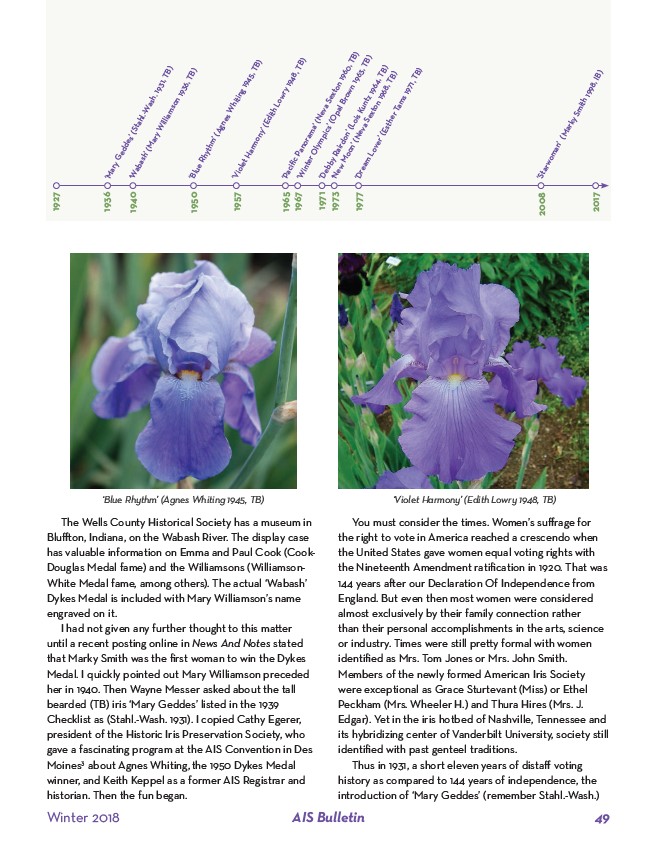
‘Mary Geddes’ (Stahl.-Wash. 1931, TB)
1936
‘Pacific Panorama’ (Neva Sexton 1960, TB)
‘Winter Olympics’ (Opal Brown 1963, TB)
‘Debby Rairdon’ (Lois Kuntz 1964, TB)
‘Dream Lover’ (Esther Tams 1971, TB)
‘New Moon’ (Neva Sexton 1968, TB)
1971
1973
1977
‘Blue Rhythm’ (Agnes Whiting 1945, TB)
‘Wabash’ (Mary Williamson 1936, TB)
1950
‘Violet Harmony’ (Edith Lowry 1948, TB)
1957
1965
1967
1940
‘Starwoman’ (Marky Smith 1998, IB)
2008
‘Blue Rhythm’ (Agnes Whiting 1945, TB) ‘Violet Harmony’ (Edith Lowry 1948, TB)
1927
The Wells County Historical Society has a museum in
Bluffton, Indiana, on the Wabash River. The display case
has valuable information on Emma and Paul Cook (Cook-
Douglas Medal fame) and the Williamsons (Williamson-
White Medal fame, among others). The actual ‘Wabash’
Dykes Medal is included with Mary Williamson’s name
engraved on it.
I had not given any further thought to this matter
until a recent posting online in News And Notes stated
that Marky Smith was the first woman to win the Dykes
Medal. I quickly pointed out Mary Williamson preceded
her in 1940. Then Wayne Messer asked about the tall
bearded (TB) iris ‘Mary Geddes’ listed in the 1939
Checklist as (Stahl.-Wash. 1931). I copied Cathy Egerer,
president of the Historic Iris Preservation Society, who
gave a fascinating program at the AIS Convention in Des
Moines3 about Agnes Whiting, the 1950 Dykes Medal
winner, and Keith Keppel as a former AIS Registrar and
historian. Then the fun began.
2017
You must consider the times. Women’s suffrage for
the right to vote in America reached a crescendo when
the United States gave women equal voting rights with
the Nineteenth Amendment ratification in 1920. That was
144 years after our Declaration Of Independence from
England. But even then most women were considered
almost exclusively by their family connection rather
than their personal accomplishments in the arts, science
or industry. Times were still pretty formal with women
identified as Mrs. Tom Jones or Mrs. John Smith.
Members of the newly formed American Iris Society
were exceptional as Grace Sturtevant (Miss) or Ethel
Peckham (Mrs. Wheeler H.) and Thura Hires (Mrs. J.
Edgar). Yet in the iris hotbed of Nashville, Tennessee and
its hybridizing center of Vanderbilt University, society still
identified with past genteel traditions.
Thus in 1931, a short eleven years of distaff voting
history as compared to 144 years of independence, the
introduction of ‘Mary Geddes’ (remember Stahl.-Wash.)
Winter 2018 AIS Bulletin 49